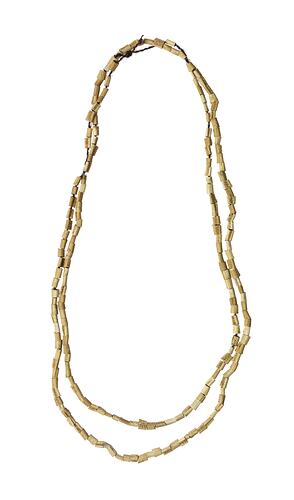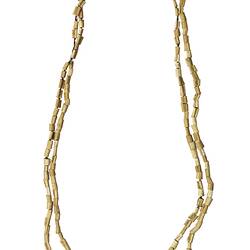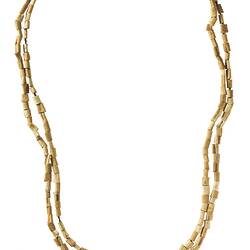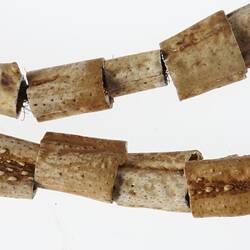Summary
Waterways are significant to Aboriginal people throughout Australia. Unique objects such as this necklace, made from small sections cut from the leg or antennae of the crayfish, highlight the ingenuity of craftspeople using their local environment. The name of the maker of this necklace is unrecorded however it is known that it came from the Warrnambool area of western Victoria. The Gunditjmara peoples are the traditional custodians of this area and have lived and practiced their culture on these lands for many hundreds of generations.
Cray fishing was and is an important seasonal activity for many Firs Peoples groups living in coastal areas. Various techniques were used to catch crayfish. Off the coast of Warrnambool, fisherman would wade into the sea when the crayfish were known to be in abundance. Moving their big toe they would entice the crayfish to latch onto their foot. Once secured the fishermen would grab the crayfish, remove its claws and place it into a basket carried across their shoulders.
Along the Murray River, women made long, narrow nets for cray fishing. Two women would drag this along the shallow parts of the river to catch the small freshwater crayfish. Lifting the net intermittently, they would remove any crayfish they had caught, placing them into string bags hanging down their backs. The women moved through the water quietly and slowly to avoid scaring the crayfish. The women also made delicate necklaces from small pieces of the crayfish shell.
Physical Description
A necklace made of crayfish shell and string.
Significance
Adornments have been used by Firs Peoples all over south-eastern Australia and beyond as both decorative, ceremonial and functional items. Such belongings, whilst looking beautiful, also served a more multilayered function such as the kangaroo tooth necklaces which were an important aspect of ceremony for many groups as well as denoting a person's status within the clan group.
For countless generations artists have depended on their knowledge of their country to source various materials and animals used to create a wealth of spectacular personal adornments. The communities that lived close to rivers and the ocean were very much a part of the ecology of these aquatic ecosystems, managing and harvesting the seasonal resources. Gunditjmara elder Iris Lovett-Gardiner speaks of the embedded cultural knowledge that allowed Gunditjmara people to live in harmony with their land;
'Our people knew the land well enough to interpret all the times when they could gather certain foods. They knew when the roots of certain plants were ready for gathering, when certain birds laid their eggs, when the honey from the wild bee could be gathered and when the grasses were green for the kangaroo to feed on. This was the interpretation of the land and our people read the signs well.' Aunty Iris Lovett-Gardiner, 2010.
References
Keeler, C. and Couzens, V., (eds) 2010, Meerreeng-An; Here is my Country: The Story of Aboriginal Victoria Told Through Art, p. 104, Koorie Heritage Trust/BPA Print Group.
More Information
-
Object/Medium
Ornament, neck
-
Maker
-
Locality
-
Date Produced
-
Object Measurements
255 mm (Length), 95 mm (Width), 20 mm (Height)
-
Classification
-
Date Made
-
Maker
-
Clan/Language Group
-
Place Made
-
Indigenous Region
-
Keywords
-
Acquisition Information
Purchase from (Estate of) Henry A. Smith, Mr H F. Richardson, 07 May 1888
-
Collection Names
-
Type of item
-
Discipline
-
Category
-
Collecting Areas



